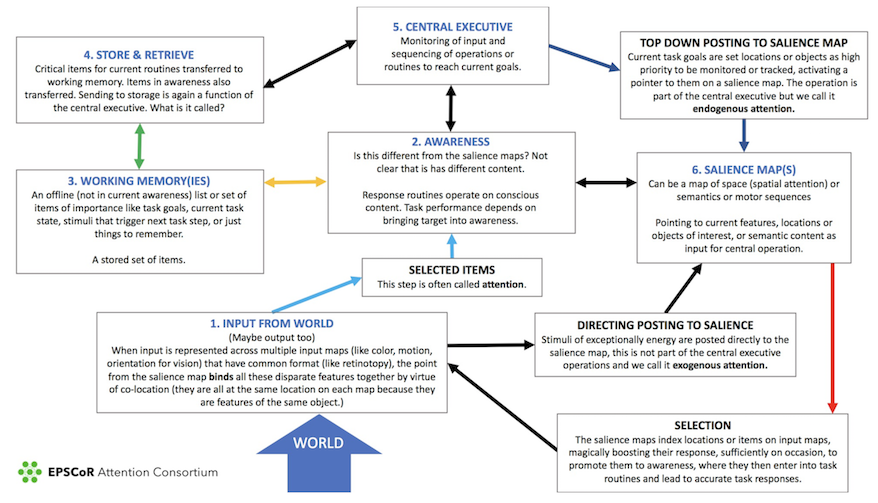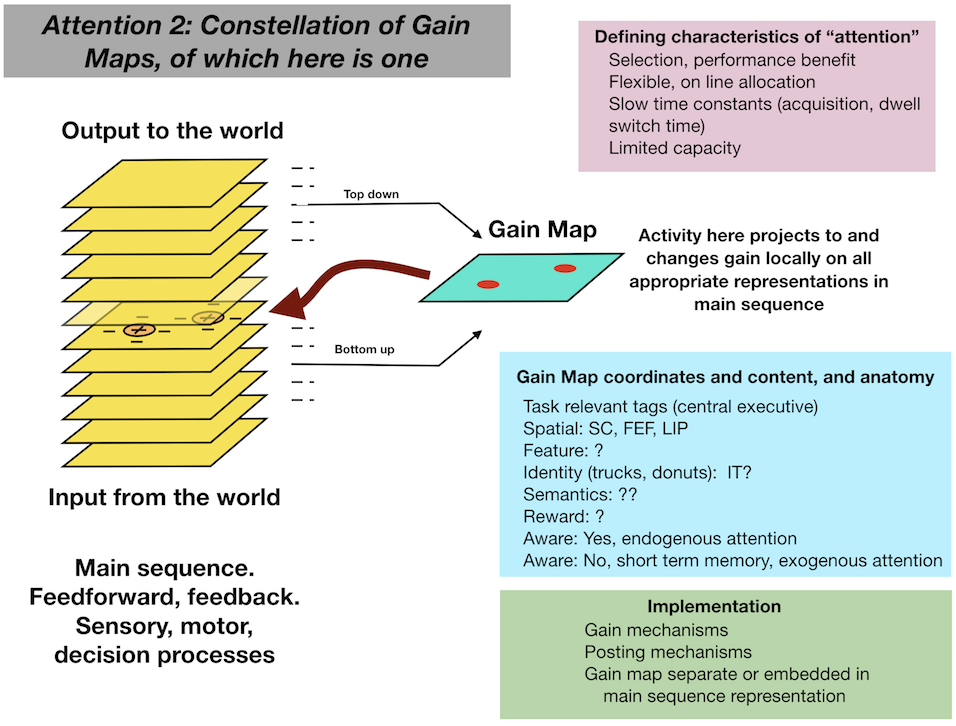Attention
Capacity, resolution, architecture
Attention is one of the most important components of cognition, it selects critical items from among the many that arrive at our ears and eyes and send them on to higher levels of processing. Attention is the final arbiter of what we experience consciously (as we proposed in Trends in Cognitive Sciences 2012) and our guide to learning about the events around us. Here is a really rough overview of the many aspects of attention developed for the EPSCoR Attention Consortium. A more general model, or schema, for attention is given further on.

Our work on the spatial and temporal resolution of attention (Nature 1996) established that, unexpectedly, attention suffers from resolution limits that are worse those of vision, by a factor of ten or more (Cognitive Psychology 2001). In many cases, we cannot pay attention to individual elements that we can see very clearly (see Crowding section). We also proposed that this resolution of attention could explain the flexible capacity limits of attention because of the competition between multiple foci of attention for a fixed amount of cortical real estate (TiCS 2013). The outcome of the competition, and so the capacity, depends on the spacing of the items within the map on which they are represented.

Although attention is often given as an example of a central, monolithic resource, it is not always so unified. Splitting the targets of a multiple object tracking task into the left and right hemifields produced a greater overall capacity than when all the targets were in one hemifield (Psych Science 2005). This result suggested that the competition between attentional foci does not extend across the anatomical divisions between left and right hemispheres.
In addition to this work on spatial attention, with Lorella Battelli, we have also discovered an unexpected property of the temporal control of attention. Specifically, damage to the right parietal lobe led to losses of temporal attention and high-level motion that were equally severe in both left and right hemifields (TiCS 2007). In contrast, damage to the left or right parietal lobe primarily affects spatial attention the contralateral hemifield (more evident for right parietal damage).
One key aspect of attention is that it can track a moving target, providing accurate estimates of its speed even when low-level motion detectors are unable to do so, like for equiluminous colour stimuli which appear to have stopped unless tracked with attention (Science, 1992). Moving attention is also able to deal with the problems of a moving stimulus that may not remain long enough over any set of local receptors to be fully processed. Moving attention ("mobile computation", Cavanagh, Holcombe & Chou, 2008) can sample a brief instant of a rapidly changing stream if it passes quickly through, giving access to events that are otherwise not seen. For example, in the movie on the left, it is difficult while fitting the central dot to say whether the inward moving texture is red or green. In the right hand movie, however, if you track the moving circle with attention while still fixating the center, you can easily tell that its red texture is moving inward.
In addition to this work on spatial attention, with Lorella Battelli, we have also discovered an unexpected property of the temporal control of attention. Specifically, damage to the right parietal lobe led to losses of temporal attention and high-level motion that were equally severe in both left and right hemifields (TiCS 2007). In contrast, damage to the left or right parietal lobe primarily affects spatial attention the contralateral hemifield (more evident for right parietal damage).
One key aspect of attention is that it can track a moving target, providing accurate estimates of its speed even when low-level motion detectors are unable to do so, like for equiluminous colour stimuli which appear to have stopped unless tracked with attention (Science, 1992). Moving attention is also able to deal with the problems of a moving stimulus that may not remain long enough over any set of local receptors to be fully processed. Moving attention ("mobile computation", Cavanagh, Holcombe & Chou, 2008) can sample a brief instant of a rapidly changing stream if it passes quickly through, giving access to events that are otherwise not seen. For example, in the movie on the left, it is difficult while fitting the central dot to say whether the inward moving texture is red or green. In the right hand movie, however, if you track the moving circle with attention while still fixating the center, you can easily tell that its red texture is moving inward.
|
|
|
Attention has been assigned so many roles, it is often difficult to determine what it is or what it does. It needs to be differentiated from learning and priming — other examples of general purpose performance enhancing mechanisms. Here is a very general idea of attention as "gain map" producing a localized enhancements (with surrounding suppression) for any map-like arrangement of data, whether in spatial coordinates or semantic, or task coordinates. There can be any number of these gain maps and each could be described as attention.
